ECON1010 Policy Brief Template for Macroeconomics 1 Course at RMIT University
VerifiedAdded on 2022/10/10
|9
|3439
|447
AI Summary
This is a policy brief template for the ECON1010 Macroeconomics 1 course at RMIT University. It includes a diagnostic analysis of Singapore's economy and recommendations for developing skills and investing in new technologies.
Contribute Materials
Your contribution can guide someone’s learning journey. Share your
documents today.
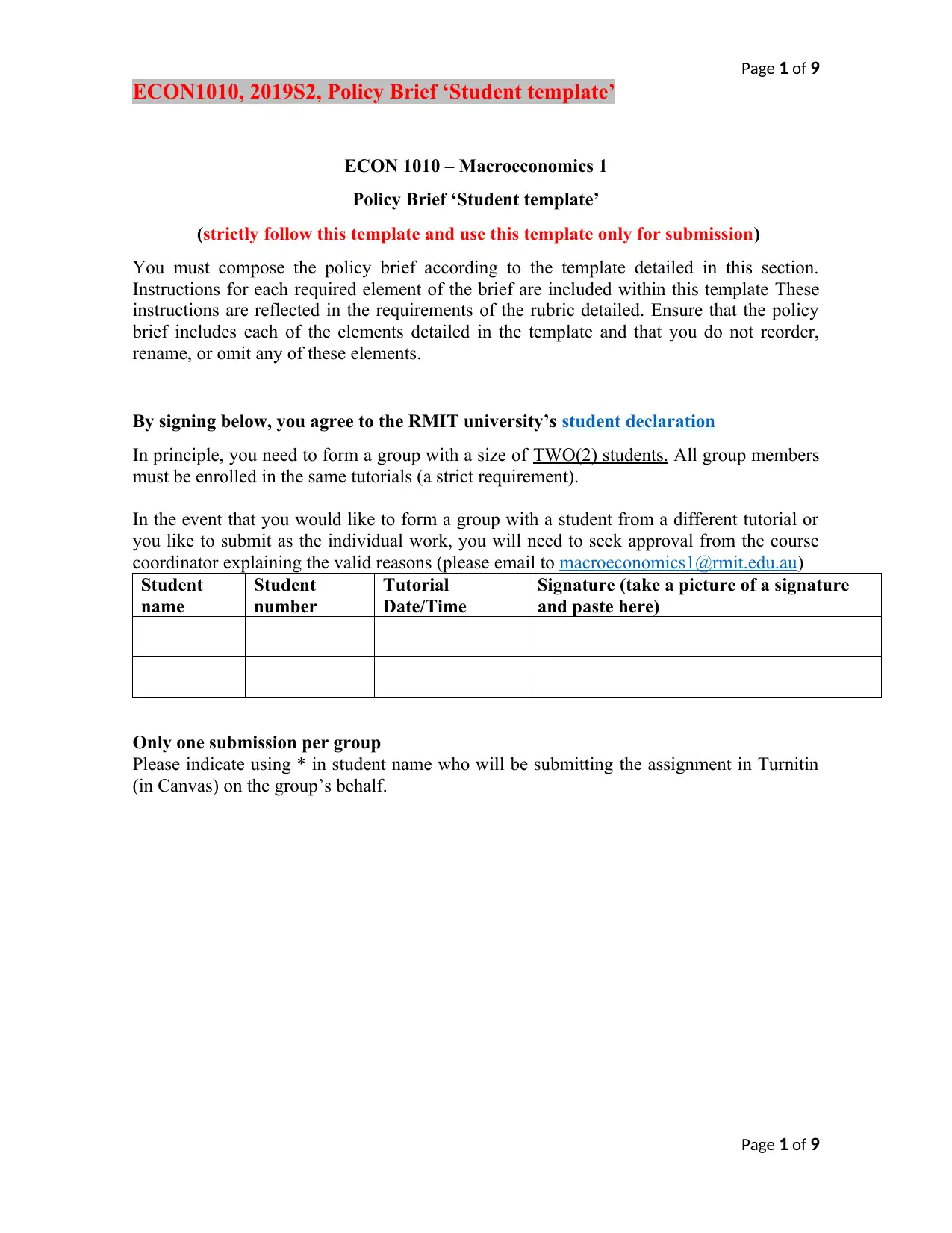
Page 1 of 9
ECON1010, 2019S2, Policy Brief ‘Student template’
ECON 1010 – Macroeconomics 1
Policy Brief ‘Student template’
(strictly follow this template and use this template only for submission)
You must compose the policy brief according to the template detailed in this section.
Instructions for each required element of the brief are included within this template These
instructions are reflected in the requirements of the rubric detailed. Ensure that the policy
brief includes each of the elements detailed in the template and that you do not reorder,
rename, or omit any of these elements.
By signing below, you agree to the RMIT university’s student declaration
In principle, you need to form a group with a size of TWO(2) students. All group members
must be enrolled in the same tutorials (a strict requirement).
In the event that you would like to form a group with a student from a different tutorial or
you like to submit as the individual work, you will need to seek approval from the course
coordinator explaining the valid reasons (please email to macroeconomics1@rmit.edu.au)
Student
name
Student
number
Tutorial
Date/Time
Signature (take a picture of a signature
and paste here)
Only one submission per group
Please indicate using * in student name who will be submitting the assignment in Turnitin
(in Canvas) on the group’s behalf.
Page 1 of 9
ECON1010, 2019S2, Policy Brief ‘Student template’
ECON 1010 – Macroeconomics 1
Policy Brief ‘Student template’
(strictly follow this template and use this template only for submission)
You must compose the policy brief according to the template detailed in this section.
Instructions for each required element of the brief are included within this template These
instructions are reflected in the requirements of the rubric detailed. Ensure that the policy
brief includes each of the elements detailed in the template and that you do not reorder,
rename, or omit any of these elements.
By signing below, you agree to the RMIT university’s student declaration
In principle, you need to form a group with a size of TWO(2) students. All group members
must be enrolled in the same tutorials (a strict requirement).
In the event that you would like to form a group with a student from a different tutorial or
you like to submit as the individual work, you will need to seek approval from the course
coordinator explaining the valid reasons (please email to macroeconomics1@rmit.edu.au)
Student
name
Student
number
Tutorial
Date/Time
Signature (take a picture of a signature
and paste here)
Only one submission per group
Please indicate using * in student name who will be submitting the assignment in Turnitin
(in Canvas) on the group’s behalf.
Page 1 of 9
Secure Best Marks with AI Grader
Need help grading? Try our AI Grader for instant feedback on your assignments.
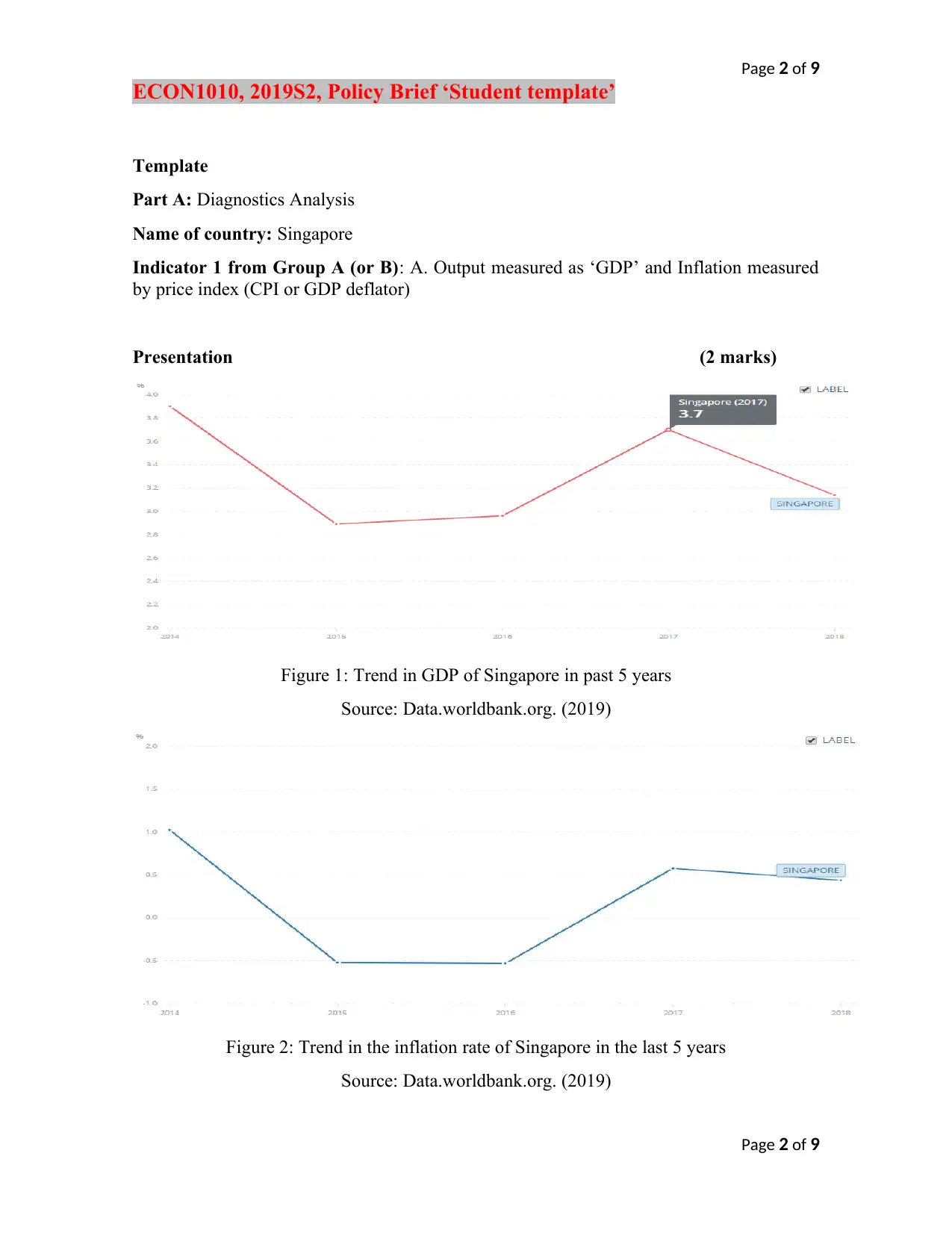
Page 2 of 9
ECON1010, 2019S2, Policy Brief ‘Student template’
Template
Part A: Diagnostics Analysis
Name of country: Singapore
Indicator 1 from Group A (or B): A. Output measured as ‘GDP’ and Inflation measured
by price index (CPI or GDP deflator)
Presentation (2 marks)
Figure 1: Trend in GDP of Singapore in past 5 years
Source: Data.worldbank.org. (2019)
Figure 2: Trend in the inflation rate of Singapore in the last 5 years
Source: Data.worldbank.org. (2019)
Page 2 of 9
ECON1010, 2019S2, Policy Brief ‘Student template’
Template
Part A: Diagnostics Analysis
Name of country: Singapore
Indicator 1 from Group A (or B): A. Output measured as ‘GDP’ and Inflation measured
by price index (CPI or GDP deflator)
Presentation (2 marks)
Figure 1: Trend in GDP of Singapore in past 5 years
Source: Data.worldbank.org. (2019)
Figure 2: Trend in the inflation rate of Singapore in the last 5 years
Source: Data.worldbank.org. (2019)
Page 2 of 9
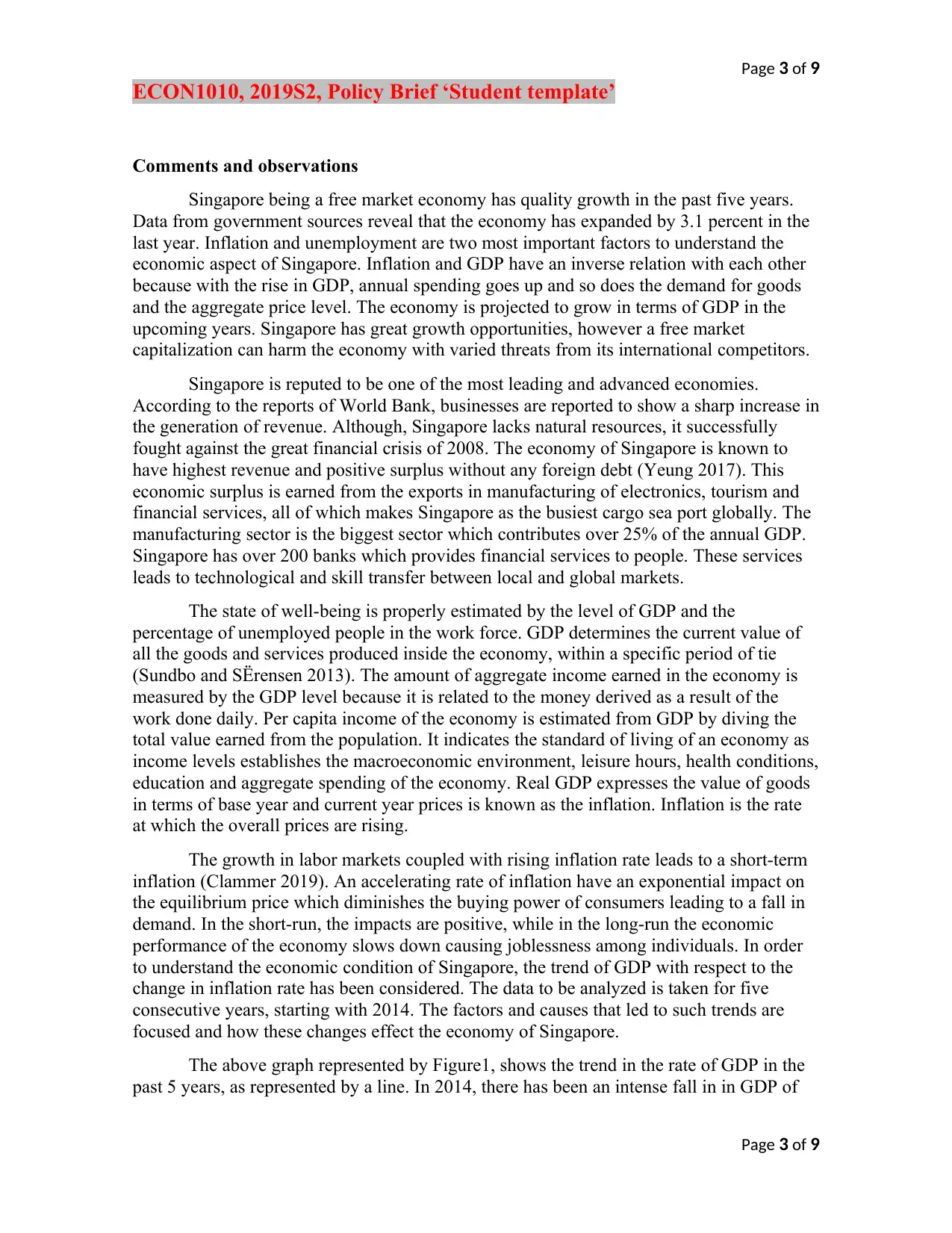
Page 3 of 9
ECON1010, 2019S2, Policy Brief ‘Student template’
Comments and observations
Singapore being a free market economy has quality growth in the past five years.
Data from government sources reveal that the economy has expanded by 3.1 percent in the
last year. Inflation and unemployment are two most important factors to understand the
economic aspect of Singapore. Inflation and GDP have an inverse relation with each other
because with the rise in GDP, annual spending goes up and so does the demand for goods
and the aggregate price level. The economy is projected to grow in terms of GDP in the
upcoming years. Singapore has great growth opportunities, however a free market
capitalization can harm the economy with varied threats from its international competitors.
Singapore is reputed to be one of the most leading and advanced economies.
According to the reports of World Bank, businesses are reported to show a sharp increase in
the generation of revenue. Although, Singapore lacks natural resources, it successfully
fought against the great financial crisis of 2008. The economy of Singapore is known to
have highest revenue and positive surplus without any foreign debt (Yeung 2017). This
economic surplus is earned from the exports in manufacturing of electronics, tourism and
financial services, all of which makes Singapore as the busiest cargo sea port globally. The
manufacturing sector is the biggest sector which contributes over 25% of the annual GDP.
Singapore has over 200 banks which provides financial services to people. These services
leads to technological and skill transfer between local and global markets.
The state of well-being is properly estimated by the level of GDP and the
percentage of unemployed people in the work force. GDP determines the current value of
all the goods and services produced inside the economy, within a specific period of tie
(Sundbo and SËrensen 2013). The amount of aggregate income earned in the economy is
measured by the GDP level because it is related to the money derived as a result of the
work done daily. Per capita income of the economy is estimated from GDP by diving the
total value earned from the population. It indicates the standard of living of an economy as
income levels establishes the macroeconomic environment, leisure hours, health conditions,
education and aggregate spending of the economy. Real GDP expresses the value of goods
in terms of base year and current year prices is known as the inflation. Inflation is the rate
at which the overall prices are rising.
The growth in labor markets coupled with rising inflation rate leads to a short-term
inflation (Clammer 2019). An accelerating rate of inflation have an exponential impact on
the equilibrium price which diminishes the buying power of consumers leading to a fall in
demand. In the short-run, the impacts are positive, while in the long-run the economic
performance of the economy slows down causing joblessness among individuals. In order
to understand the economic condition of Singapore, the trend of GDP with respect to the
change in inflation rate has been considered. The data to be analyzed is taken for five
consecutive years, starting with 2014. The factors and causes that led to such trends are
focused and how these changes effect the economy of Singapore.
The above graph represented by Figure1, shows the trend in the rate of GDP in the
past 5 years, as represented by a line. In 2014, there has been an intense fall in in GDP of
Page 3 of 9
ECON1010, 2019S2, Policy Brief ‘Student template’
Comments and observations
Singapore being a free market economy has quality growth in the past five years.
Data from government sources reveal that the economy has expanded by 3.1 percent in the
last year. Inflation and unemployment are two most important factors to understand the
economic aspect of Singapore. Inflation and GDP have an inverse relation with each other
because with the rise in GDP, annual spending goes up and so does the demand for goods
and the aggregate price level. The economy is projected to grow in terms of GDP in the
upcoming years. Singapore has great growth opportunities, however a free market
capitalization can harm the economy with varied threats from its international competitors.
Singapore is reputed to be one of the most leading and advanced economies.
According to the reports of World Bank, businesses are reported to show a sharp increase in
the generation of revenue. Although, Singapore lacks natural resources, it successfully
fought against the great financial crisis of 2008. The economy of Singapore is known to
have highest revenue and positive surplus without any foreign debt (Yeung 2017). This
economic surplus is earned from the exports in manufacturing of electronics, tourism and
financial services, all of which makes Singapore as the busiest cargo sea port globally. The
manufacturing sector is the biggest sector which contributes over 25% of the annual GDP.
Singapore has over 200 banks which provides financial services to people. These services
leads to technological and skill transfer between local and global markets.
The state of well-being is properly estimated by the level of GDP and the
percentage of unemployed people in the work force. GDP determines the current value of
all the goods and services produced inside the economy, within a specific period of tie
(Sundbo and SËrensen 2013). The amount of aggregate income earned in the economy is
measured by the GDP level because it is related to the money derived as a result of the
work done daily. Per capita income of the economy is estimated from GDP by diving the
total value earned from the population. It indicates the standard of living of an economy as
income levels establishes the macroeconomic environment, leisure hours, health conditions,
education and aggregate spending of the economy. Real GDP expresses the value of goods
in terms of base year and current year prices is known as the inflation. Inflation is the rate
at which the overall prices are rising.
The growth in labor markets coupled with rising inflation rate leads to a short-term
inflation (Clammer 2019). An accelerating rate of inflation have an exponential impact on
the equilibrium price which diminishes the buying power of consumers leading to a fall in
demand. In the short-run, the impacts are positive, while in the long-run the economic
performance of the economy slows down causing joblessness among individuals. In order
to understand the economic condition of Singapore, the trend of GDP with respect to the
change in inflation rate has been considered. The data to be analyzed is taken for five
consecutive years, starting with 2014. The factors and causes that led to such trends are
focused and how these changes effect the economy of Singapore.
The above graph represented by Figure1, shows the trend in the rate of GDP in the
past 5 years, as represented by a line. In 2014, there has been an intense fall in in GDP of
Page 3 of 9
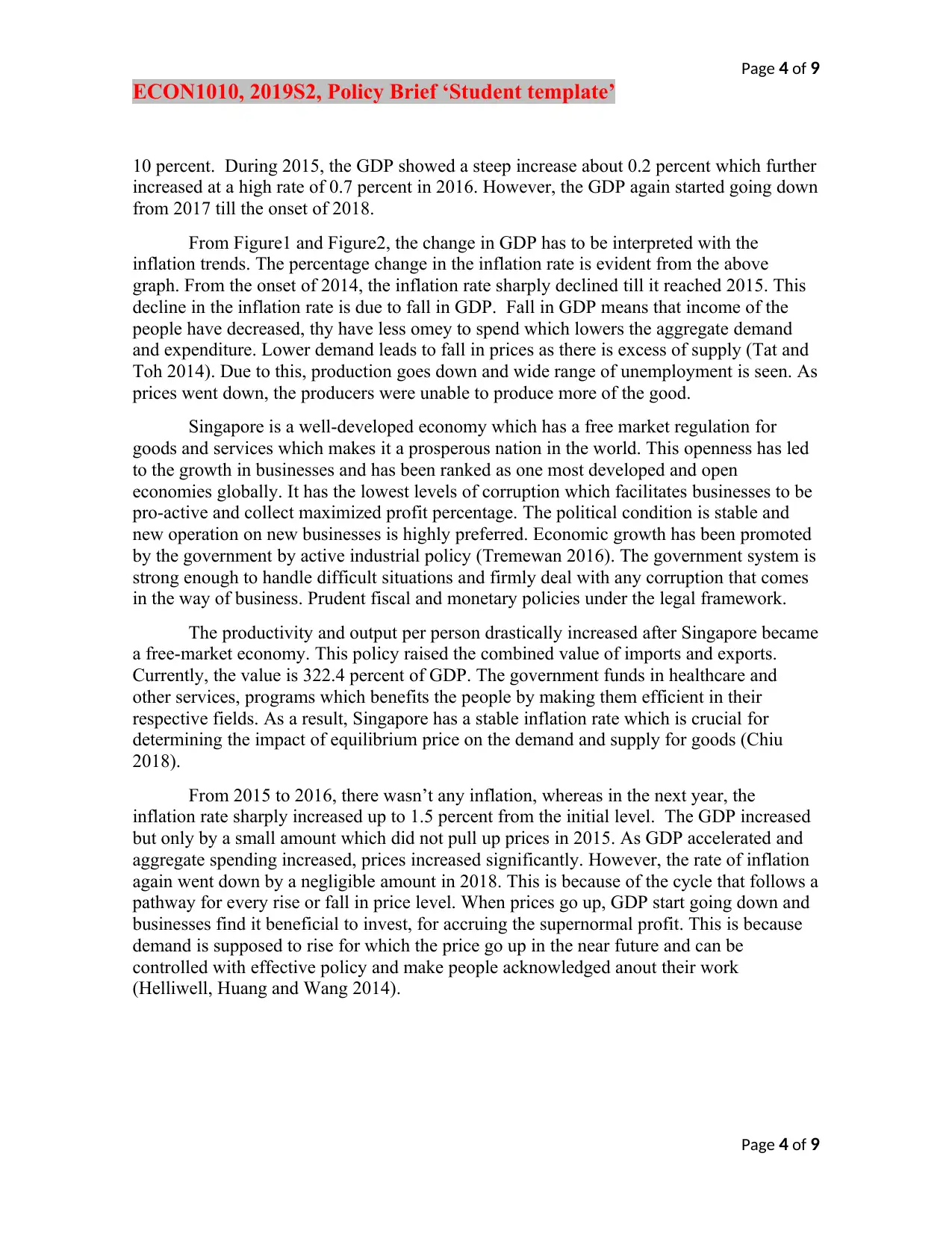
Page 4 of 9
ECON1010, 2019S2, Policy Brief ‘Student template’
10 percent. During 2015, the GDP showed a steep increase about 0.2 percent which further
increased at a high rate of 0.7 percent in 2016. However, the GDP again started going down
from 2017 till the onset of 2018.
From Figure1 and Figure2, the change in GDP has to be interpreted with the
inflation trends. The percentage change in the inflation rate is evident from the above
graph. From the onset of 2014, the inflation rate sharply declined till it reached 2015. This
decline in the inflation rate is due to fall in GDP. Fall in GDP means that income of the
people have decreased, thy have less omey to spend which lowers the aggregate demand
and expenditure. Lower demand leads to fall in prices as there is excess of supply (Tat and
Toh 2014). Due to this, production goes down and wide range of unemployment is seen. As
prices went down, the producers were unable to produce more of the good.
Singapore is a well-developed economy which has a free market regulation for
goods and services which makes it a prosperous nation in the world. This openness has led
to the growth in businesses and has been ranked as one most developed and open
economies globally. It has the lowest levels of corruption which facilitates businesses to be
pro-active and collect maximized profit percentage. The political condition is stable and
new operation on new businesses is highly preferred. Economic growth has been promoted
by the government by active industrial policy (Tremewan 2016). The government system is
strong enough to handle difficult situations and firmly deal with any corruption that comes
in the way of business. Prudent fiscal and monetary policies under the legal framework.
The productivity and output per person drastically increased after Singapore became
a free-market economy. This policy raised the combined value of imports and exports.
Currently, the value is 322.4 percent of GDP. The government funds in healthcare and
other services, programs which benefits the people by making them efficient in their
respective fields. As a result, Singapore has a stable inflation rate which is crucial for
determining the impact of equilibrium price on the demand and supply for goods (Chiu
2018).
From 2015 to 2016, there wasn’t any inflation, whereas in the next year, the
inflation rate sharply increased up to 1.5 percent from the initial level. The GDP increased
but only by a small amount which did not pull up prices in 2015. As GDP accelerated and
aggregate spending increased, prices increased significantly. However, the rate of inflation
again went down by a negligible amount in 2018. This is because of the cycle that follows a
pathway for every rise or fall in price level. When prices go up, GDP start going down and
businesses find it beneficial to invest, for accruing the supernormal profit. This is because
demand is supposed to rise for which the price go up in the near future and can be
controlled with effective policy and make people acknowledged anout their work
(Helliwell, Huang and Wang 2014).
Page 4 of 9
ECON1010, 2019S2, Policy Brief ‘Student template’
10 percent. During 2015, the GDP showed a steep increase about 0.2 percent which further
increased at a high rate of 0.7 percent in 2016. However, the GDP again started going down
from 2017 till the onset of 2018.
From Figure1 and Figure2, the change in GDP has to be interpreted with the
inflation trends. The percentage change in the inflation rate is evident from the above
graph. From the onset of 2014, the inflation rate sharply declined till it reached 2015. This
decline in the inflation rate is due to fall in GDP. Fall in GDP means that income of the
people have decreased, thy have less omey to spend which lowers the aggregate demand
and expenditure. Lower demand leads to fall in prices as there is excess of supply (Tat and
Toh 2014). Due to this, production goes down and wide range of unemployment is seen. As
prices went down, the producers were unable to produce more of the good.
Singapore is a well-developed economy which has a free market regulation for
goods and services which makes it a prosperous nation in the world. This openness has led
to the growth in businesses and has been ranked as one most developed and open
economies globally. It has the lowest levels of corruption which facilitates businesses to be
pro-active and collect maximized profit percentage. The political condition is stable and
new operation on new businesses is highly preferred. Economic growth has been promoted
by the government by active industrial policy (Tremewan 2016). The government system is
strong enough to handle difficult situations and firmly deal with any corruption that comes
in the way of business. Prudent fiscal and monetary policies under the legal framework.
The productivity and output per person drastically increased after Singapore became
a free-market economy. This policy raised the combined value of imports and exports.
Currently, the value is 322.4 percent of GDP. The government funds in healthcare and
other services, programs which benefits the people by making them efficient in their
respective fields. As a result, Singapore has a stable inflation rate which is crucial for
determining the impact of equilibrium price on the demand and supply for goods (Chiu
2018).
From 2015 to 2016, there wasn’t any inflation, whereas in the next year, the
inflation rate sharply increased up to 1.5 percent from the initial level. The GDP increased
but only by a small amount which did not pull up prices in 2015. As GDP accelerated and
aggregate spending increased, prices increased significantly. However, the rate of inflation
again went down by a negligible amount in 2018. This is because of the cycle that follows a
pathway for every rise or fall in price level. When prices go up, GDP start going down and
businesses find it beneficial to invest, for accruing the supernormal profit. This is because
demand is supposed to rise for which the price go up in the near future and can be
controlled with effective policy and make people acknowledged anout their work
(Helliwell, Huang and Wang 2014).
Page 4 of 9
Secure Best Marks with AI Grader
Need help grading? Try our AI Grader for instant feedback on your assignments.
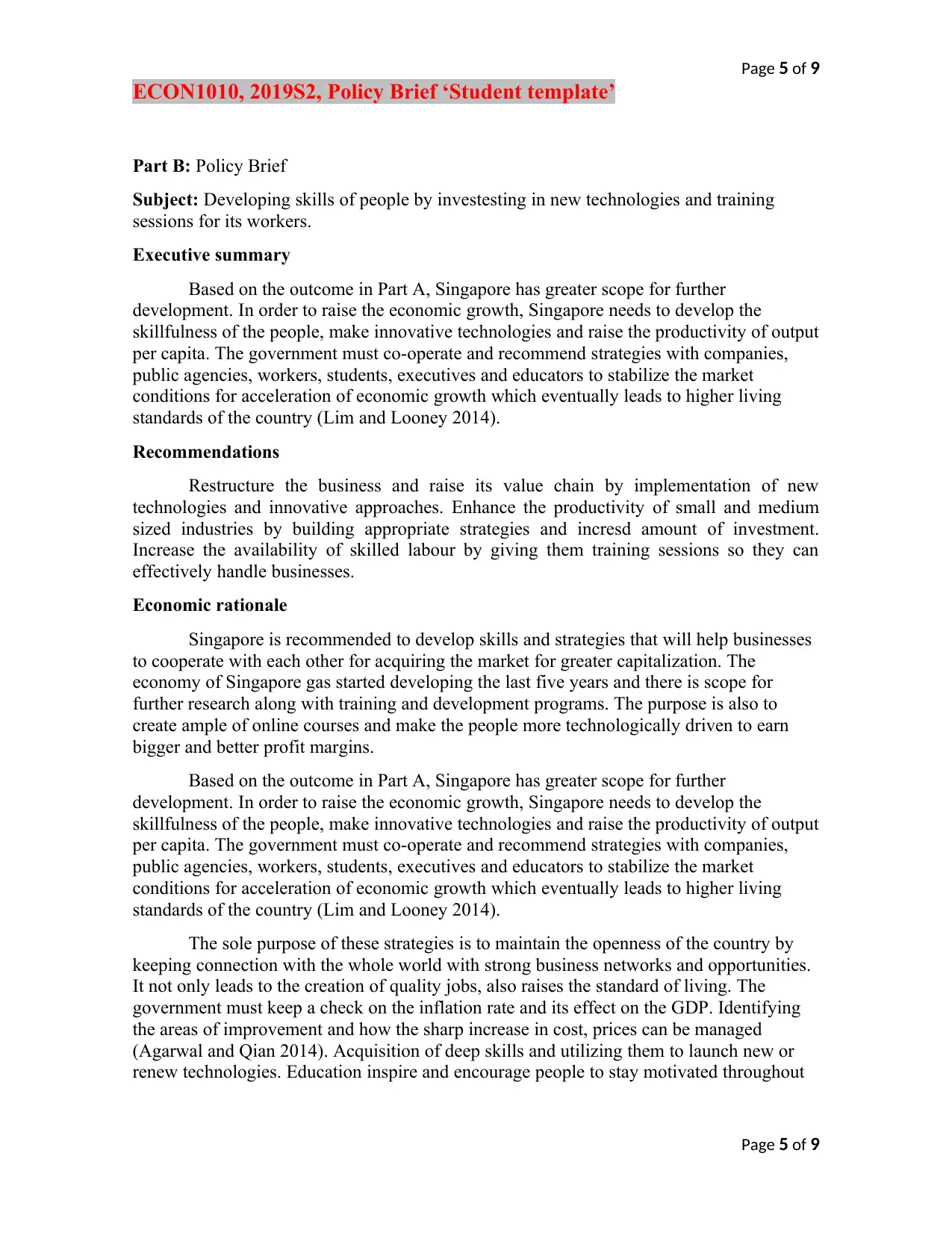
Page 5 of 9
ECON1010, 2019S2, Policy Brief ‘Student template’
Part B: Policy Brief
Subject: Developing skills of people by investesting in new technologies and training
sessions for its workers.
Executive summary
Based on the outcome in Part A, Singapore has greater scope for further
development. In order to raise the economic growth, Singapore needs to develop the
skillfulness of the people, make innovative technologies and raise the productivity of output
per capita. The government must co-operate and recommend strategies with companies,
public agencies, workers, students, executives and educators to stabilize the market
conditions for acceleration of economic growth which eventually leads to higher living
standards of the country (Lim and Looney 2014).
Recommendations
Restructure the business and raise its value chain by implementation of new
technologies and innovative approaches. Enhance the productivity of small and medium
sized industries by building appropriate strategies and incresd amount of investment.
Increase the availability of skilled labour by giving them training sessions so they can
effectively handle businesses.
Economic rationale
Singapore is recommended to develop skills and strategies that will help businesses
to cooperate with each other for acquiring the market for greater capitalization. The
economy of Singapore gas started developing the last five years and there is scope for
further research along with training and development programs. The purpose is also to
create ample of online courses and make the people more technologically driven to earn
bigger and better profit margins.
Based on the outcome in Part A, Singapore has greater scope for further
development. In order to raise the economic growth, Singapore needs to develop the
skillfulness of the people, make innovative technologies and raise the productivity of output
per capita. The government must co-operate and recommend strategies with companies,
public agencies, workers, students, executives and educators to stabilize the market
conditions for acceleration of economic growth which eventually leads to higher living
standards of the country (Lim and Looney 2014).
The sole purpose of these strategies is to maintain the openness of the country by
keeping connection with the whole world with strong business networks and opportunities.
It not only leads to the creation of quality jobs, also raises the standard of living. The
government must keep a check on the inflation rate and its effect on the GDP. Identifying
the areas of improvement and how the sharp increase in cost, prices can be managed
(Agarwal and Qian 2014). Acquisition of deep skills and utilizing them to launch new or
renew technologies. Education inspire and encourage people to stay motivated throughout
Page 5 of 9
ECON1010, 2019S2, Policy Brief ‘Student template’
Part B: Policy Brief
Subject: Developing skills of people by investesting in new technologies and training
sessions for its workers.
Executive summary
Based on the outcome in Part A, Singapore has greater scope for further
development. In order to raise the economic growth, Singapore needs to develop the
skillfulness of the people, make innovative technologies and raise the productivity of output
per capita. The government must co-operate and recommend strategies with companies,
public agencies, workers, students, executives and educators to stabilize the market
conditions for acceleration of economic growth which eventually leads to higher living
standards of the country (Lim and Looney 2014).
Recommendations
Restructure the business and raise its value chain by implementation of new
technologies and innovative approaches. Enhance the productivity of small and medium
sized industries by building appropriate strategies and incresd amount of investment.
Increase the availability of skilled labour by giving them training sessions so they can
effectively handle businesses.
Economic rationale
Singapore is recommended to develop skills and strategies that will help businesses
to cooperate with each other for acquiring the market for greater capitalization. The
economy of Singapore gas started developing the last five years and there is scope for
further research along with training and development programs. The purpose is also to
create ample of online courses and make the people more technologically driven to earn
bigger and better profit margins.
Based on the outcome in Part A, Singapore has greater scope for further
development. In order to raise the economic growth, Singapore needs to develop the
skillfulness of the people, make innovative technologies and raise the productivity of output
per capita. The government must co-operate and recommend strategies with companies,
public agencies, workers, students, executives and educators to stabilize the market
conditions for acceleration of economic growth which eventually leads to higher living
standards of the country (Lim and Looney 2014).
The sole purpose of these strategies is to maintain the openness of the country by
keeping connection with the whole world with strong business networks and opportunities.
It not only leads to the creation of quality jobs, also raises the standard of living. The
government must keep a check on the inflation rate and its effect on the GDP. Identifying
the areas of improvement and how the sharp increase in cost, prices can be managed
(Agarwal and Qian 2014). Acquisition of deep skills and utilizing them to launch new or
renew technologies. Education inspire and encourage people to stay motivated throughout
Page 5 of 9
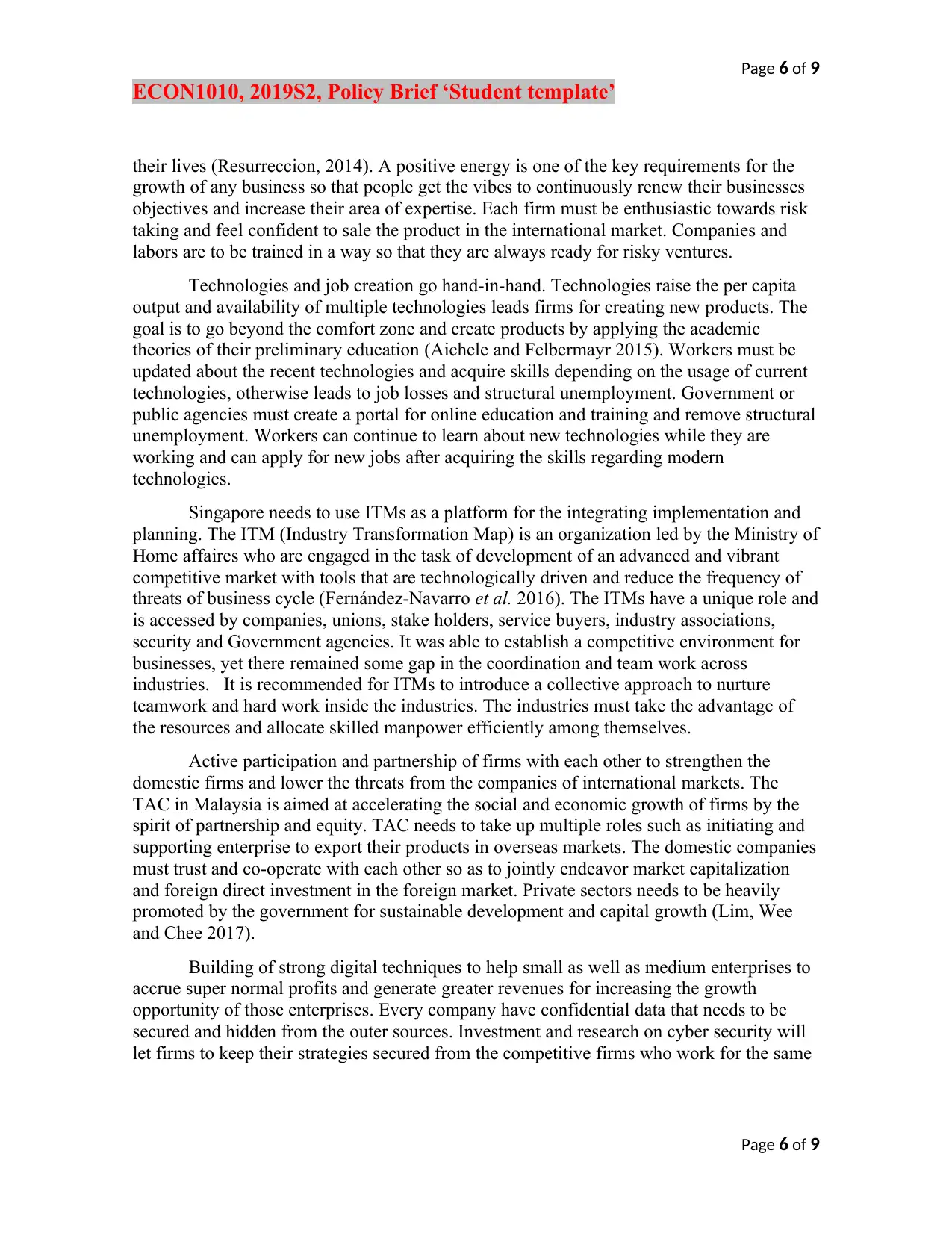
Page 6 of 9
ECON1010, 2019S2, Policy Brief ‘Student template’
their lives (Resurreccion, 2014). A positive energy is one of the key requirements for the
growth of any business so that people get the vibes to continuously renew their businesses
objectives and increase their area of expertise. Each firm must be enthusiastic towards risk
taking and feel confident to sale the product in the international market. Companies and
labors are to be trained in a way so that they are always ready for risky ventures.
Technologies and job creation go hand-in-hand. Technologies raise the per capita
output and availability of multiple technologies leads firms for creating new products. The
goal is to go beyond the comfort zone and create products by applying the academic
theories of their preliminary education (Aichele and Felbermayr 2015). Workers must be
updated about the recent technologies and acquire skills depending on the usage of current
technologies, otherwise leads to job losses and structural unemployment. Government or
public agencies must create a portal for online education and training and remove structural
unemployment. Workers can continue to learn about new technologies while they are
working and can apply for new jobs after acquiring the skills regarding modern
technologies.
Singapore needs to use ITMs as a platform for the integrating implementation and
planning. The ITM (Industry Transformation Map) is an organization led by the Ministry of
Home affaires who are engaged in the task of development of an advanced and vibrant
competitive market with tools that are technologically driven and reduce the frequency of
threats of business cycle (Fernández-Navarro et al. 2016). The ITMs have a unique role and
is accessed by companies, unions, stake holders, service buyers, industry associations,
security and Government agencies. It was able to establish a competitive environment for
businesses, yet there remained some gap in the coordination and team work across
industries. It is recommended for ITMs to introduce a collective approach to nurture
teamwork and hard work inside the industries. The industries must take the advantage of
the resources and allocate skilled manpower efficiently among themselves.
Active participation and partnership of firms with each other to strengthen the
domestic firms and lower the threats from the companies of international markets. The
TAC in Malaysia is aimed at accelerating the social and economic growth of firms by the
spirit of partnership and equity. TAC needs to take up multiple roles such as initiating and
supporting enterprise to export their products in overseas markets. The domestic companies
must trust and co-operate with each other so as to jointly endeavor market capitalization
and foreign direct investment in the foreign market. Private sectors needs to be heavily
promoted by the government for sustainable development and capital growth (Lim, Wee
and Chee 2017).
Building of strong digital techniques to help small as well as medium enterprises to
accrue super normal profits and generate greater revenues for increasing the growth
opportunity of those enterprises. Every company have confidential data that needs to be
secured and hidden from the outer sources. Investment and research on cyber security will
let firms to keep their strategies secured from the competitive firms who work for the same
Page 6 of 9
ECON1010, 2019S2, Policy Brief ‘Student template’
their lives (Resurreccion, 2014). A positive energy is one of the key requirements for the
growth of any business so that people get the vibes to continuously renew their businesses
objectives and increase their area of expertise. Each firm must be enthusiastic towards risk
taking and feel confident to sale the product in the international market. Companies and
labors are to be trained in a way so that they are always ready for risky ventures.
Technologies and job creation go hand-in-hand. Technologies raise the per capita
output and availability of multiple technologies leads firms for creating new products. The
goal is to go beyond the comfort zone and create products by applying the academic
theories of their preliminary education (Aichele and Felbermayr 2015). Workers must be
updated about the recent technologies and acquire skills depending on the usage of current
technologies, otherwise leads to job losses and structural unemployment. Government or
public agencies must create a portal for online education and training and remove structural
unemployment. Workers can continue to learn about new technologies while they are
working and can apply for new jobs after acquiring the skills regarding modern
technologies.
Singapore needs to use ITMs as a platform for the integrating implementation and
planning. The ITM (Industry Transformation Map) is an organization led by the Ministry of
Home affaires who are engaged in the task of development of an advanced and vibrant
competitive market with tools that are technologically driven and reduce the frequency of
threats of business cycle (Fernández-Navarro et al. 2016). The ITMs have a unique role and
is accessed by companies, unions, stake holders, service buyers, industry associations,
security and Government agencies. It was able to establish a competitive environment for
businesses, yet there remained some gap in the coordination and team work across
industries. It is recommended for ITMs to introduce a collective approach to nurture
teamwork and hard work inside the industries. The industries must take the advantage of
the resources and allocate skilled manpower efficiently among themselves.
Active participation and partnership of firms with each other to strengthen the
domestic firms and lower the threats from the companies of international markets. The
TAC in Malaysia is aimed at accelerating the social and economic growth of firms by the
spirit of partnership and equity. TAC needs to take up multiple roles such as initiating and
supporting enterprise to export their products in overseas markets. The domestic companies
must trust and co-operate with each other so as to jointly endeavor market capitalization
and foreign direct investment in the foreign market. Private sectors needs to be heavily
promoted by the government for sustainable development and capital growth (Lim, Wee
and Chee 2017).
Building of strong digital techniques to help small as well as medium enterprises to
accrue super normal profits and generate greater revenues for increasing the growth
opportunity of those enterprises. Every company have confidential data that needs to be
secured and hidden from the outer sources. Investment and research on cyber security will
let firms to keep their strategies secured from the competitive firms who work for the same
Page 6 of 9
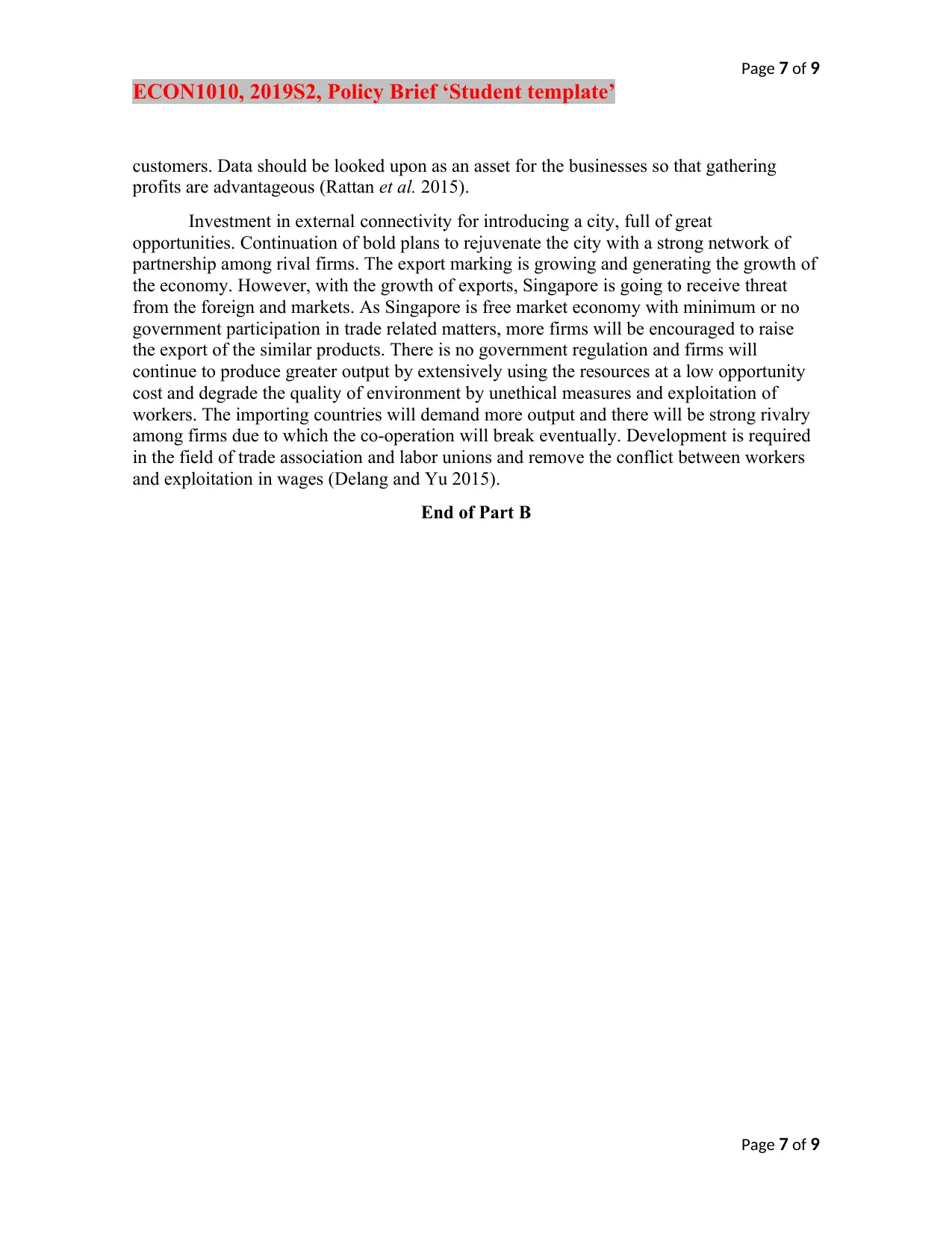
Page 7 of 9
ECON1010, 2019S2, Policy Brief ‘Student template’
customers. Data should be looked upon as an asset for the businesses so that gathering
profits are advantageous (Rattan et al. 2015).
Investment in external connectivity for introducing a city, full of great
opportunities. Continuation of bold plans to rejuvenate the city with a strong network of
partnership among rival firms. The export marking is growing and generating the growth of
the economy. However, with the growth of exports, Singapore is going to receive threat
from the foreign and markets. As Singapore is free market economy with minimum or no
government participation in trade related matters, more firms will be encouraged to raise
the export of the similar products. There is no government regulation and firms will
continue to produce greater output by extensively using the resources at a low opportunity
cost and degrade the quality of environment by unethical measures and exploitation of
workers. The importing countries will demand more output and there will be strong rivalry
among firms due to which the co-operation will break eventually. Development is required
in the field of trade association and labor unions and remove the conflict between workers
and exploitation in wages (Delang and Yu 2015).
End of Part B
Page 7 of 9
ECON1010, 2019S2, Policy Brief ‘Student template’
customers. Data should be looked upon as an asset for the businesses so that gathering
profits are advantageous (Rattan et al. 2015).
Investment in external connectivity for introducing a city, full of great
opportunities. Continuation of bold plans to rejuvenate the city with a strong network of
partnership among rival firms. The export marking is growing and generating the growth of
the economy. However, with the growth of exports, Singapore is going to receive threat
from the foreign and markets. As Singapore is free market economy with minimum or no
government participation in trade related matters, more firms will be encouraged to raise
the export of the similar products. There is no government regulation and firms will
continue to produce greater output by extensively using the resources at a low opportunity
cost and degrade the quality of environment by unethical measures and exploitation of
workers. The importing countries will demand more output and there will be strong rivalry
among firms due to which the co-operation will break eventually. Development is required
in the field of trade association and labor unions and remove the conflict between workers
and exploitation in wages (Delang and Yu 2015).
End of Part B
Page 7 of 9
Paraphrase This Document
Need a fresh take? Get an instant paraphrase of this document with our AI Paraphraser
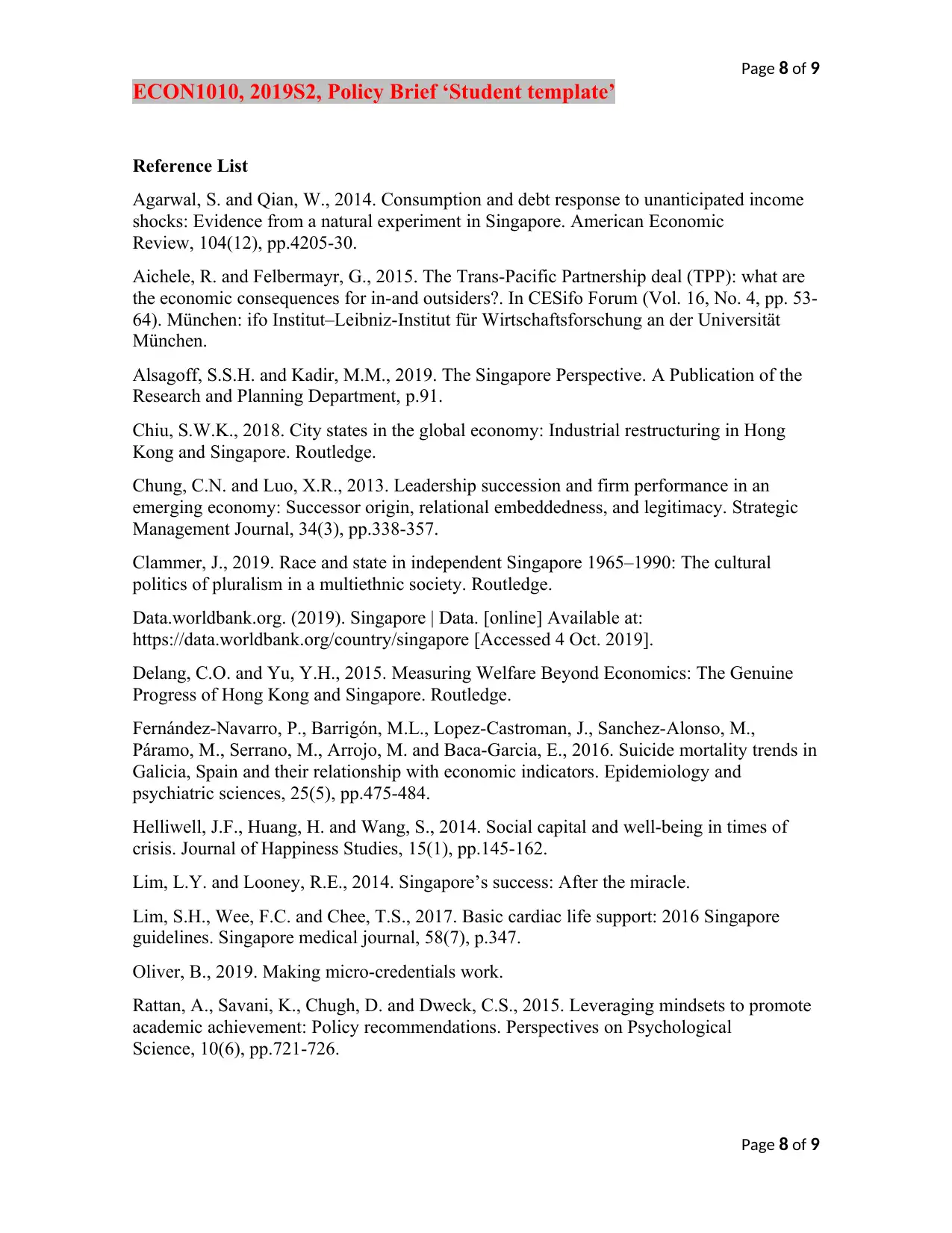
Page 8 of 9
ECON1010, 2019S2, Policy Brief ‘Student template’
Reference List
Agarwal, S. and Qian, W., 2014. Consumption and debt response to unanticipated income
shocks: Evidence from a natural experiment in Singapore. American Economic
Review, 104(12), pp.4205-30.
Aichele, R. and Felbermayr, G., 2015. The Trans-Pacific Partnership deal (TPP): what are
the economic consequences for in-and outsiders?. In CESifo Forum (Vol. 16, No. 4, pp. 53-
64). München: ifo Institut–Leibniz-Institut für Wirtschaftsforschung an der Universität
München.
Alsagoff, S.S.H. and Kadir, M.M., 2019. The Singapore Perspective. A Publication of the
Research and Planning Department, p.91.
Chiu, S.W.K., 2018. City states in the global economy: Industrial restructuring in Hong
Kong and Singapore. Routledge.
Chung, C.N. and Luo, X.R., 2013. Leadership succession and firm performance in an
emerging economy: Successor origin, relational embeddedness, and legitimacy. Strategic
Management Journal, 34(3), pp.338-357.
Clammer, J., 2019. Race and state in independent Singapore 1965–1990: The cultural
politics of pluralism in a multiethnic society. Routledge.
Data.worldbank.org. (2019). Singapore | Data. [online] Available at:
https://data.worldbank.org/country/singapore [Accessed 4 Oct. 2019].
Delang, C.O. and Yu, Y.H., 2015. Measuring Welfare Beyond Economics: The Genuine
Progress of Hong Kong and Singapore. Routledge.
Fernández-Navarro, P., Barrigón, M.L., Lopez-Castroman, J., Sanchez-Alonso, M.,
Páramo, M., Serrano, M., Arrojo, M. and Baca-Garcia, E., 2016. Suicide mortality trends in
Galicia, Spain and their relationship with economic indicators. Epidemiology and
psychiatric sciences, 25(5), pp.475-484.
Helliwell, J.F., Huang, H. and Wang, S., 2014. Social capital and well-being in times of
crisis. Journal of Happiness Studies, 15(1), pp.145-162.
Lim, L.Y. and Looney, R.E., 2014. Singapore’s success: After the miracle.
Lim, S.H., Wee, F.C. and Chee, T.S., 2017. Basic cardiac life support: 2016 Singapore
guidelines. Singapore medical journal, 58(7), p.347.
Oliver, B., 2019. Making micro-credentials work.
Rattan, A., Savani, K., Chugh, D. and Dweck, C.S., 2015. Leveraging mindsets to promote
academic achievement: Policy recommendations. Perspectives on Psychological
Science, 10(6), pp.721-726.
Page 8 of 9
ECON1010, 2019S2, Policy Brief ‘Student template’
Reference List
Agarwal, S. and Qian, W., 2014. Consumption and debt response to unanticipated income
shocks: Evidence from a natural experiment in Singapore. American Economic
Review, 104(12), pp.4205-30.
Aichele, R. and Felbermayr, G., 2015. The Trans-Pacific Partnership deal (TPP): what are
the economic consequences for in-and outsiders?. In CESifo Forum (Vol. 16, No. 4, pp. 53-
64). München: ifo Institut–Leibniz-Institut für Wirtschaftsforschung an der Universität
München.
Alsagoff, S.S.H. and Kadir, M.M., 2019. The Singapore Perspective. A Publication of the
Research and Planning Department, p.91.
Chiu, S.W.K., 2018. City states in the global economy: Industrial restructuring in Hong
Kong and Singapore. Routledge.
Chung, C.N. and Luo, X.R., 2013. Leadership succession and firm performance in an
emerging economy: Successor origin, relational embeddedness, and legitimacy. Strategic
Management Journal, 34(3), pp.338-357.
Clammer, J., 2019. Race and state in independent Singapore 1965–1990: The cultural
politics of pluralism in a multiethnic society. Routledge.
Data.worldbank.org. (2019). Singapore | Data. [online] Available at:
https://data.worldbank.org/country/singapore [Accessed 4 Oct. 2019].
Delang, C.O. and Yu, Y.H., 2015. Measuring Welfare Beyond Economics: The Genuine
Progress of Hong Kong and Singapore. Routledge.
Fernández-Navarro, P., Barrigón, M.L., Lopez-Castroman, J., Sanchez-Alonso, M.,
Páramo, M., Serrano, M., Arrojo, M. and Baca-Garcia, E., 2016. Suicide mortality trends in
Galicia, Spain and their relationship with economic indicators. Epidemiology and
psychiatric sciences, 25(5), pp.475-484.
Helliwell, J.F., Huang, H. and Wang, S., 2014. Social capital and well-being in times of
crisis. Journal of Happiness Studies, 15(1), pp.145-162.
Lim, L.Y. and Looney, R.E., 2014. Singapore’s success: After the miracle.
Lim, S.H., Wee, F.C. and Chee, T.S., 2017. Basic cardiac life support: 2016 Singapore
guidelines. Singapore medical journal, 58(7), p.347.
Oliver, B., 2019. Making micro-credentials work.
Rattan, A., Savani, K., Chugh, D. and Dweck, C.S., 2015. Leveraging mindsets to promote
academic achievement: Policy recommendations. Perspectives on Psychological
Science, 10(6), pp.721-726.
Page 8 of 9
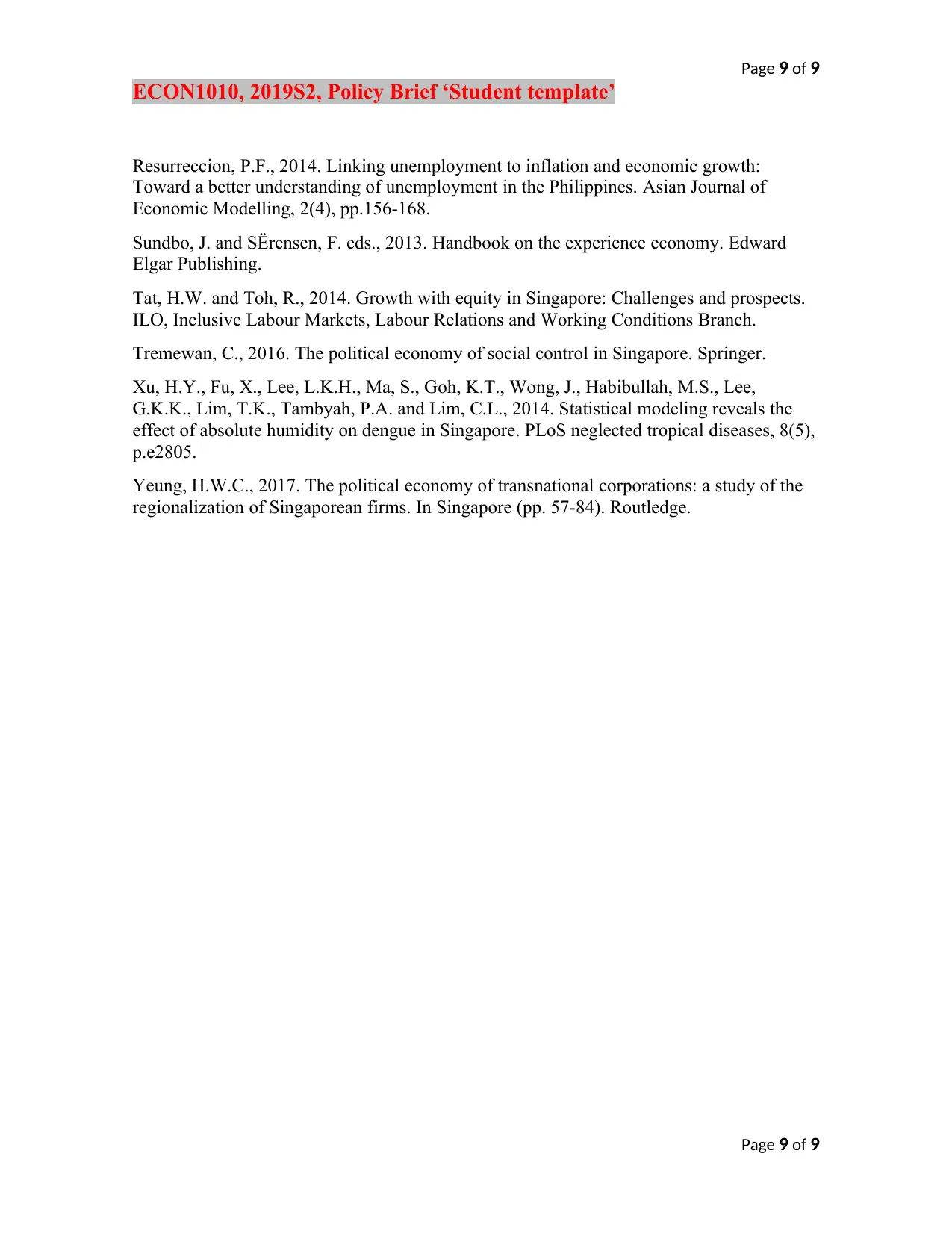
Page 9 of 9
ECON1010, 2019S2, Policy Brief ‘Student template’
Resurreccion, P.F., 2014. Linking unemployment to inflation and economic growth:
Toward a better understanding of unemployment in the Philippines. Asian Journal of
Economic Modelling, 2(4), pp.156-168.
Sundbo, J. and SËrensen, F. eds., 2013. Handbook on the experience economy. Edward
Elgar Publishing.
Tat, H.W. and Toh, R., 2014. Growth with equity in Singapore: Challenges and prospects.
ILO, Inclusive Labour Markets, Labour Relations and Working Conditions Branch.
Tremewan, C., 2016. The political economy of social control in Singapore. Springer.
Xu, H.Y., Fu, X., Lee, L.K.H., Ma, S., Goh, K.T., Wong, J., Habibullah, M.S., Lee,
G.K.K., Lim, T.K., Tambyah, P.A. and Lim, C.L., 2014. Statistical modeling reveals the
effect of absolute humidity on dengue in Singapore. PLoS neglected tropical diseases, 8(5),
p.e2805.
Yeung, H.W.C., 2017. The political economy of transnational corporations: a study of the
regionalization of Singaporean firms. In Singapore (pp. 57-84). Routledge.
Page 9 of 9
ECON1010, 2019S2, Policy Brief ‘Student template’
Resurreccion, P.F., 2014. Linking unemployment to inflation and economic growth:
Toward a better understanding of unemployment in the Philippines. Asian Journal of
Economic Modelling, 2(4), pp.156-168.
Sundbo, J. and SËrensen, F. eds., 2013. Handbook on the experience economy. Edward
Elgar Publishing.
Tat, H.W. and Toh, R., 2014. Growth with equity in Singapore: Challenges and prospects.
ILO, Inclusive Labour Markets, Labour Relations and Working Conditions Branch.
Tremewan, C., 2016. The political economy of social control in Singapore. Springer.
Xu, H.Y., Fu, X., Lee, L.K.H., Ma, S., Goh, K.T., Wong, J., Habibullah, M.S., Lee,
G.K.K., Lim, T.K., Tambyah, P.A. and Lim, C.L., 2014. Statistical modeling reveals the
effect of absolute humidity on dengue in Singapore. PLoS neglected tropical diseases, 8(5),
p.e2805.
Yeung, H.W.C., 2017. The political economy of transnational corporations: a study of the
regionalization of Singaporean firms. In Singapore (pp. 57-84). Routledge.
Page 9 of 9
1 out of 9
Related Documents
Your All-in-One AI-Powered Toolkit for Academic Success.
+13062052269
info@desklib.com
Available 24*7 on WhatsApp / Email
![[object Object]](/_next/static/media/star-bottom.7253800d.svg)
Unlock your academic potential
© 2024 | Zucol Services PVT LTD | All rights reserved.


![[SOLVED] Defense Industry and Emerging Technologies](/_next/image/?url=https%3A%2F%2Fdesklib.com%2Fmedia%2Fimages%2Fhy%2F6d274e1ff9fd44309a43c120240fa0a3.jpg&w=256&q=75)


